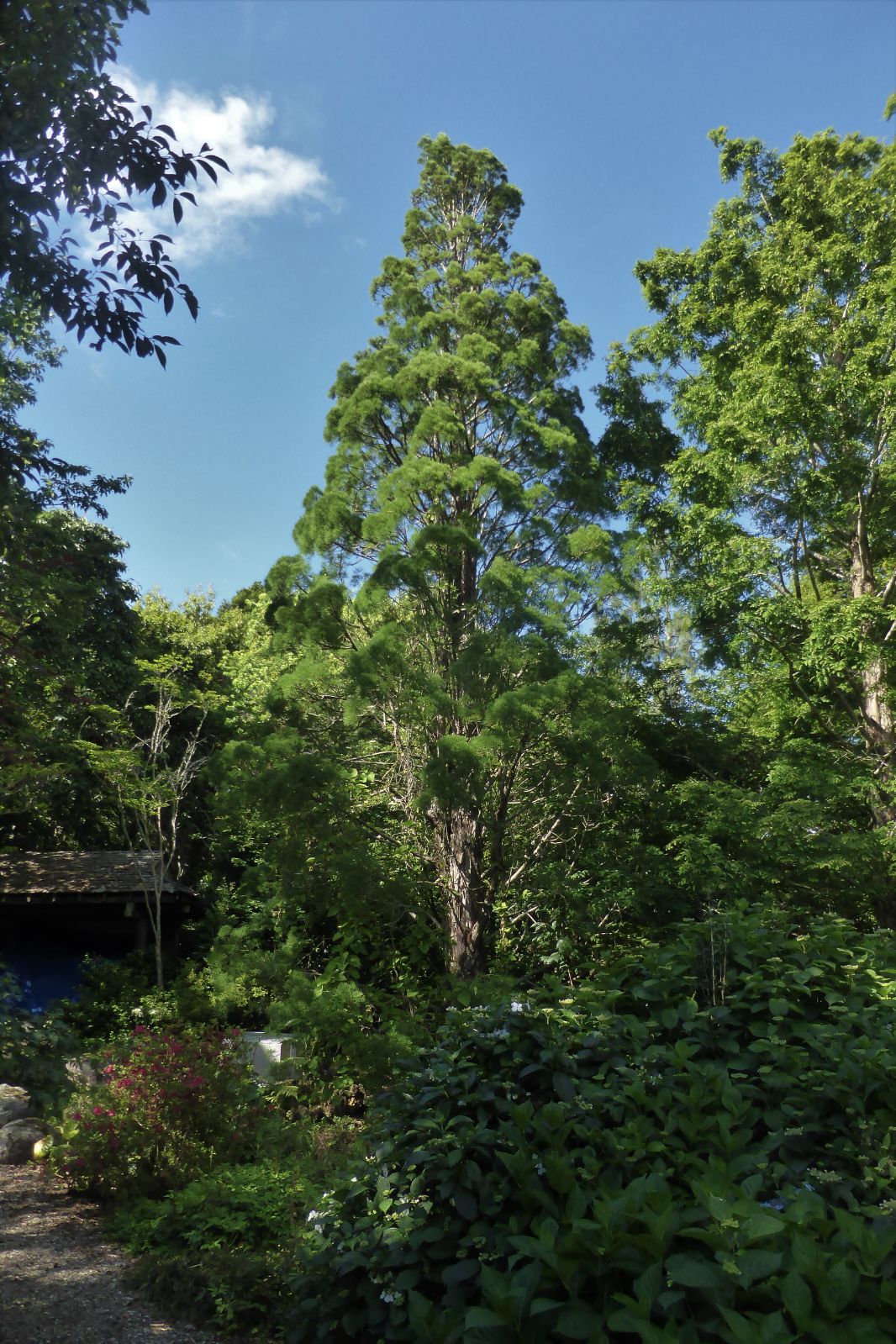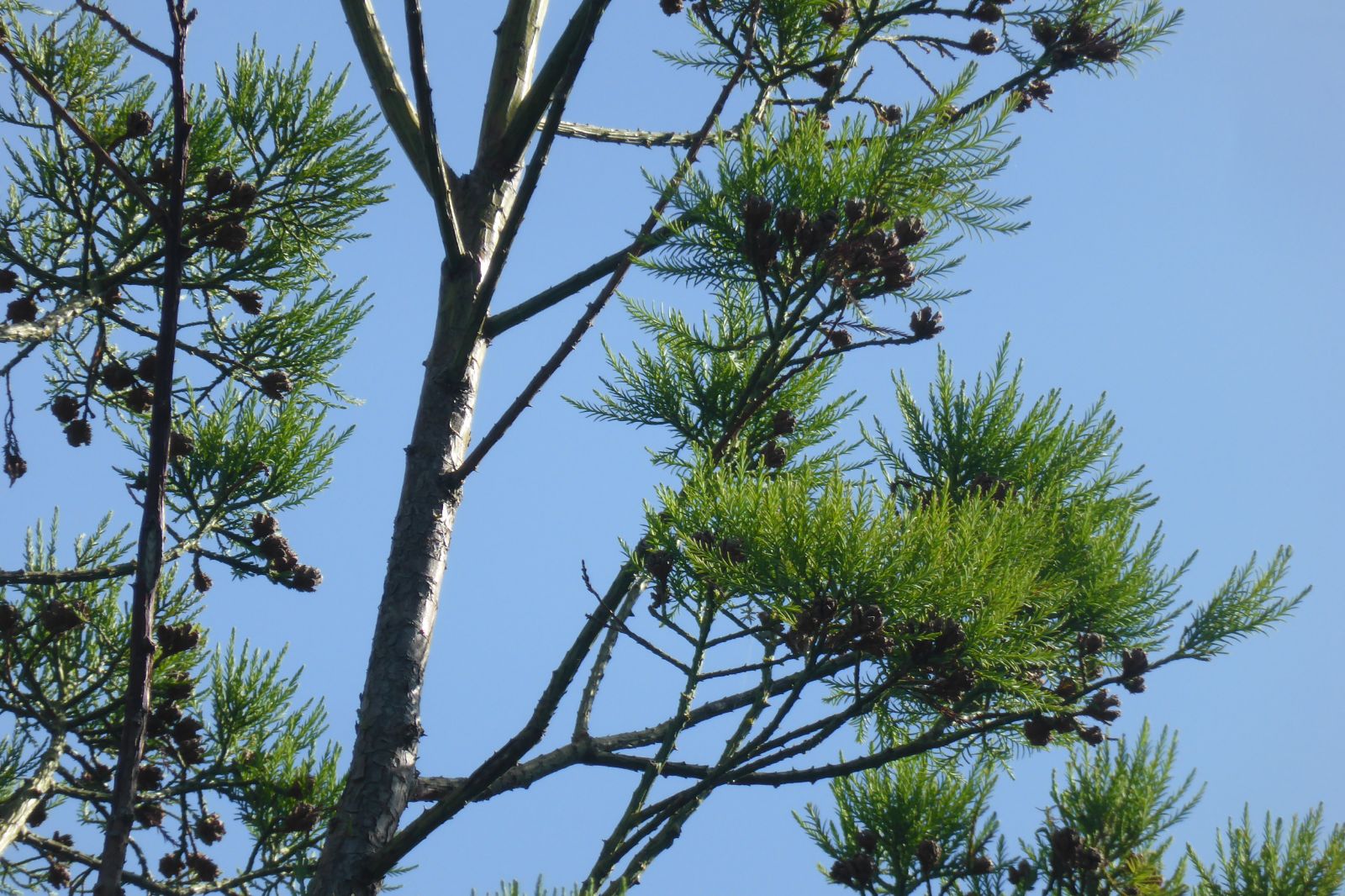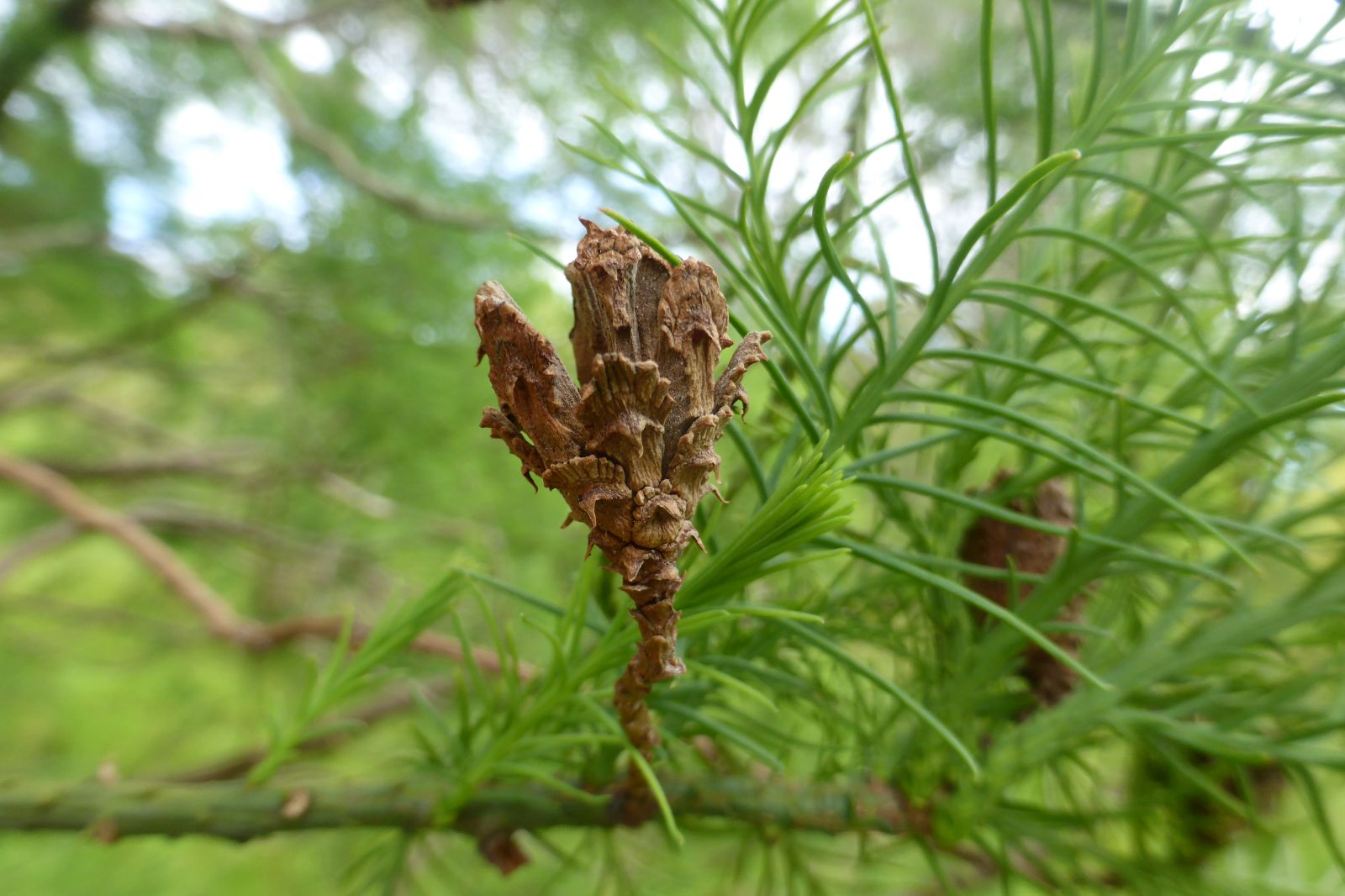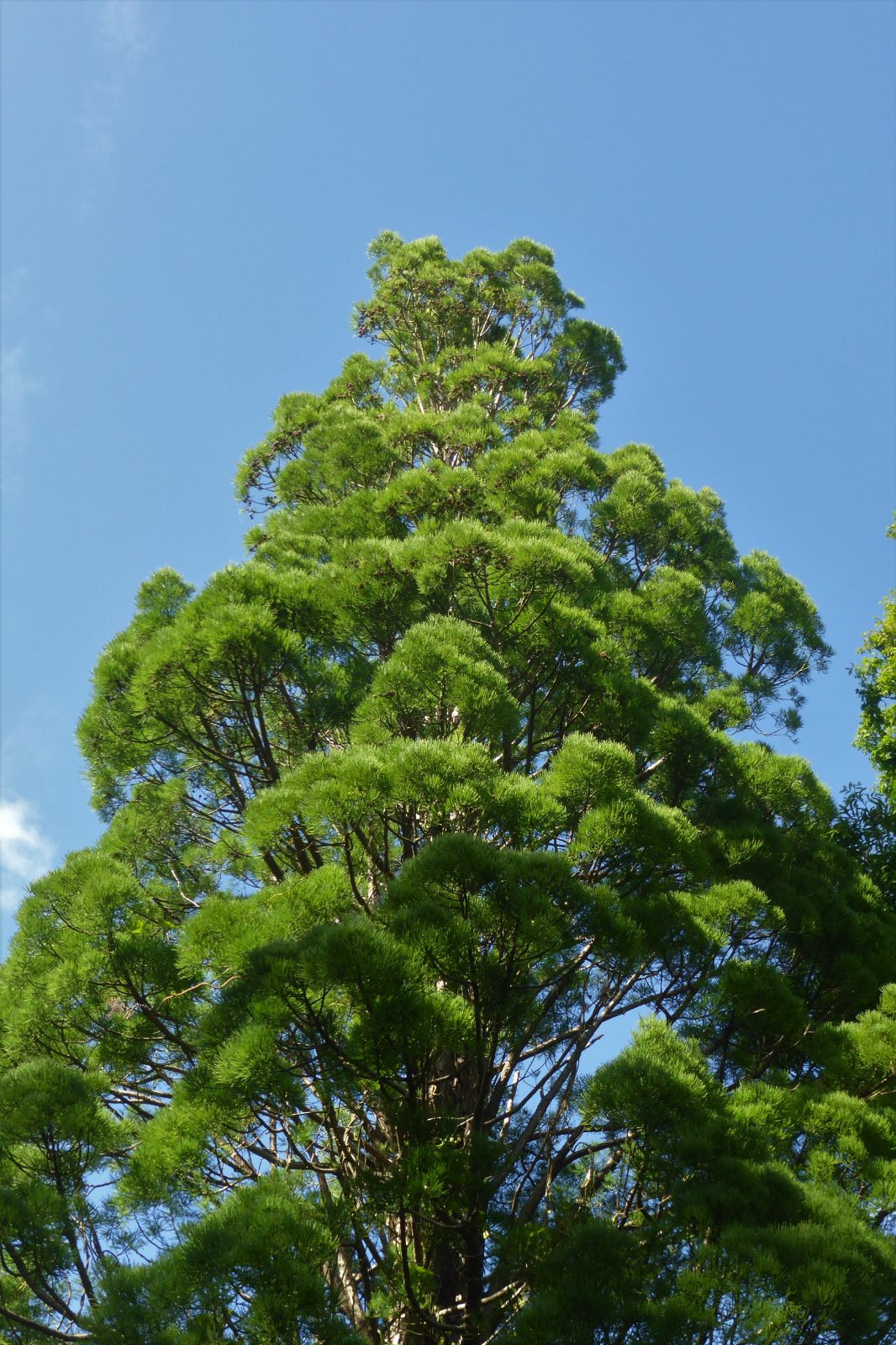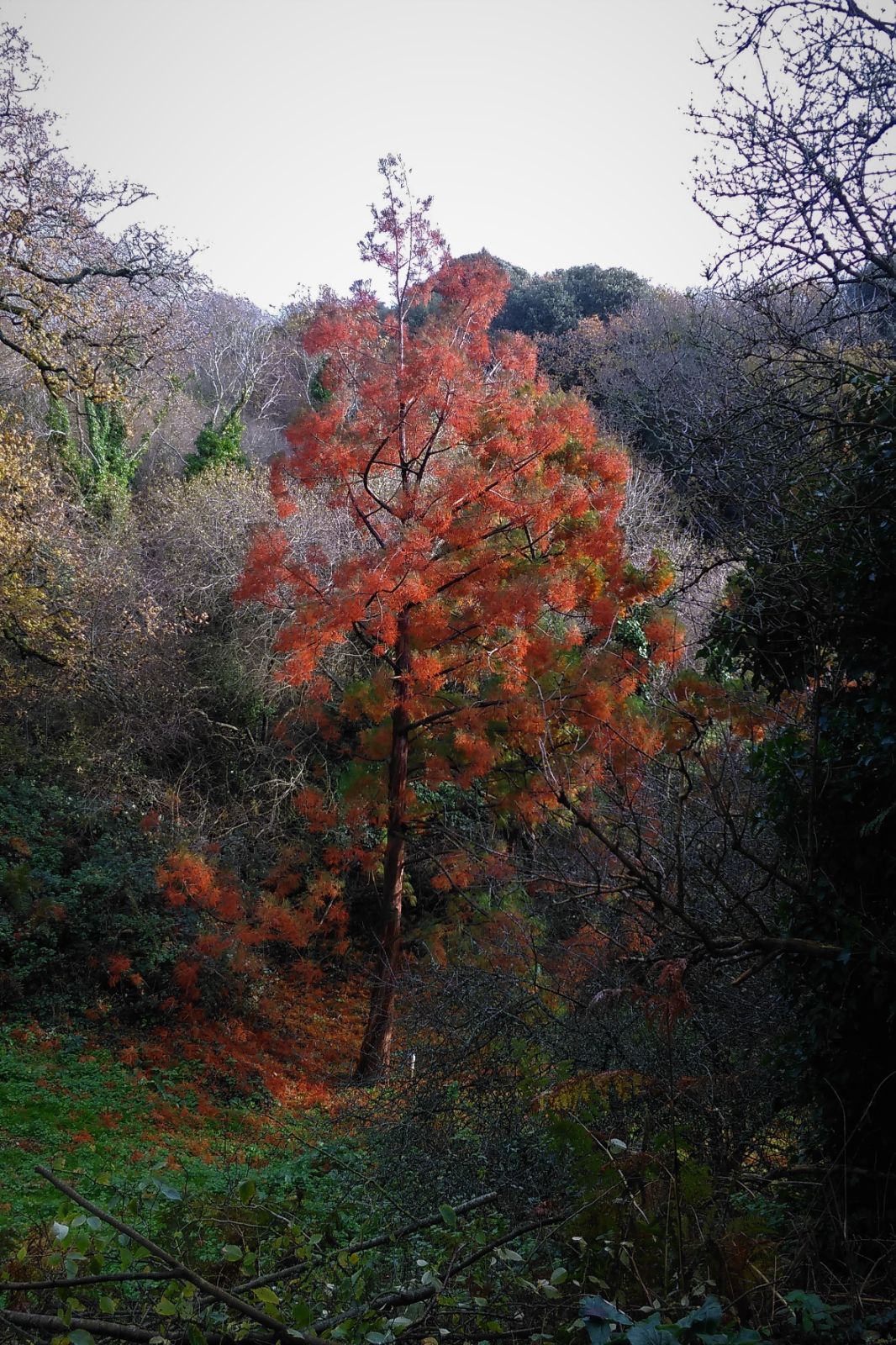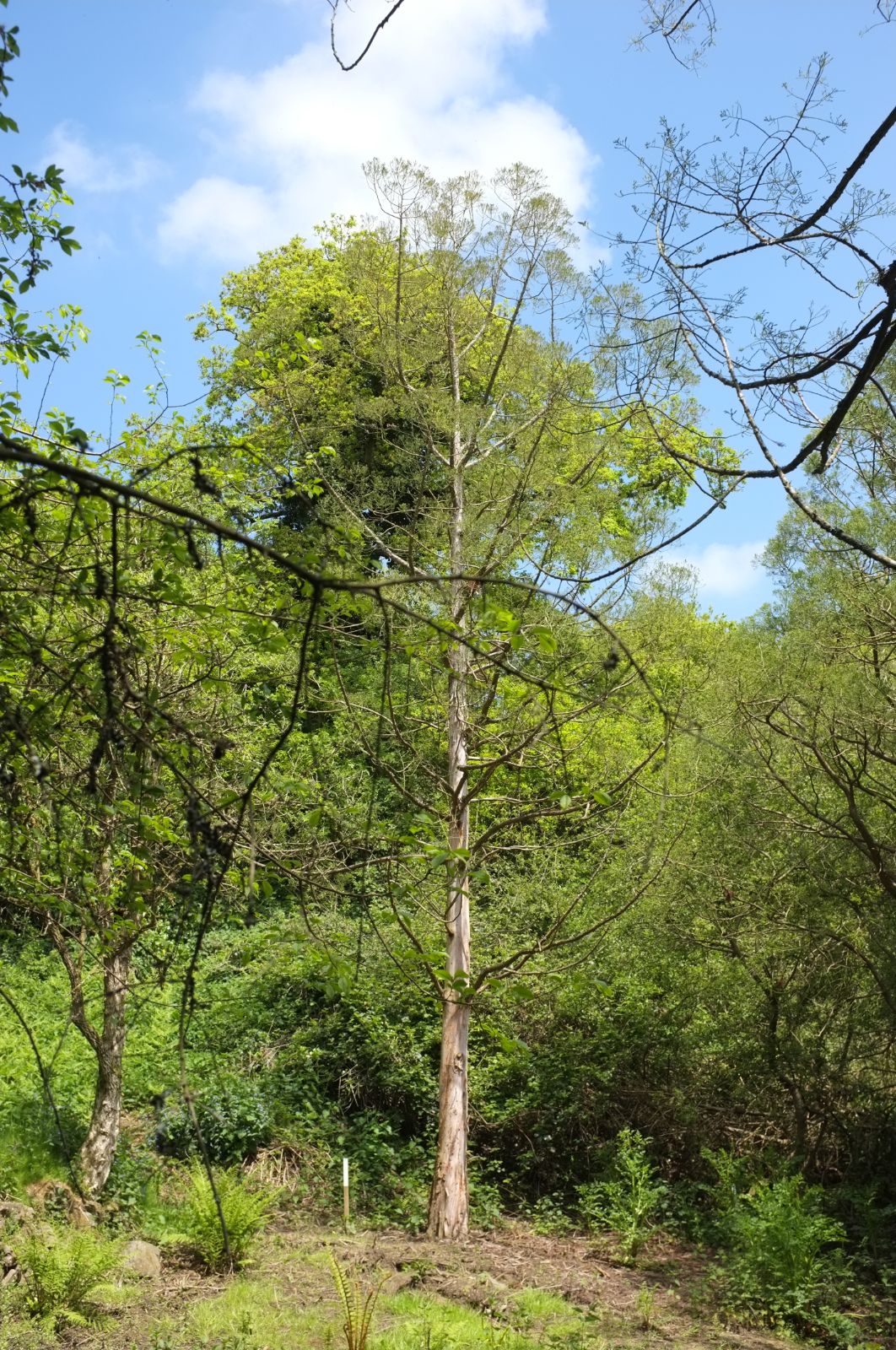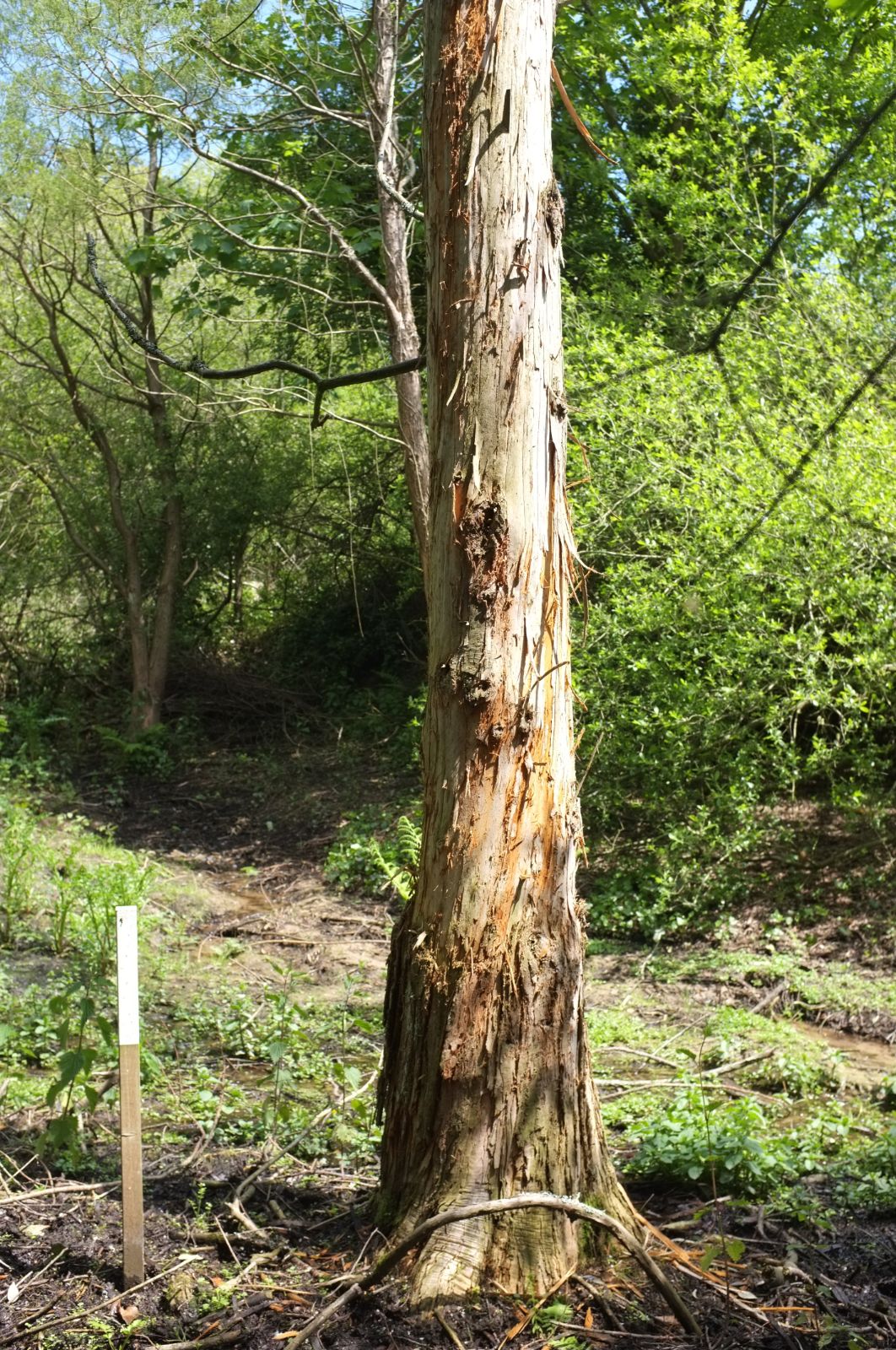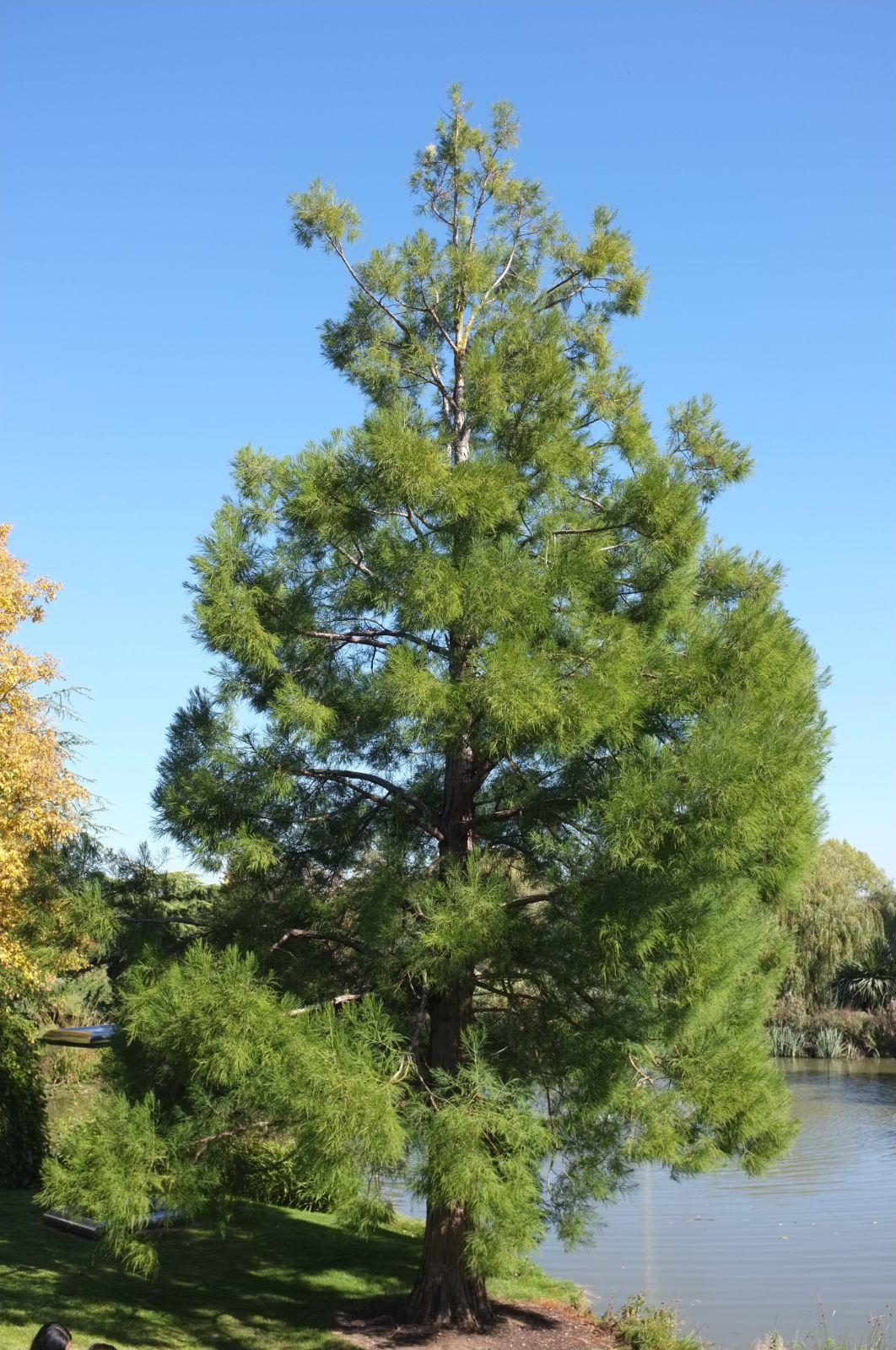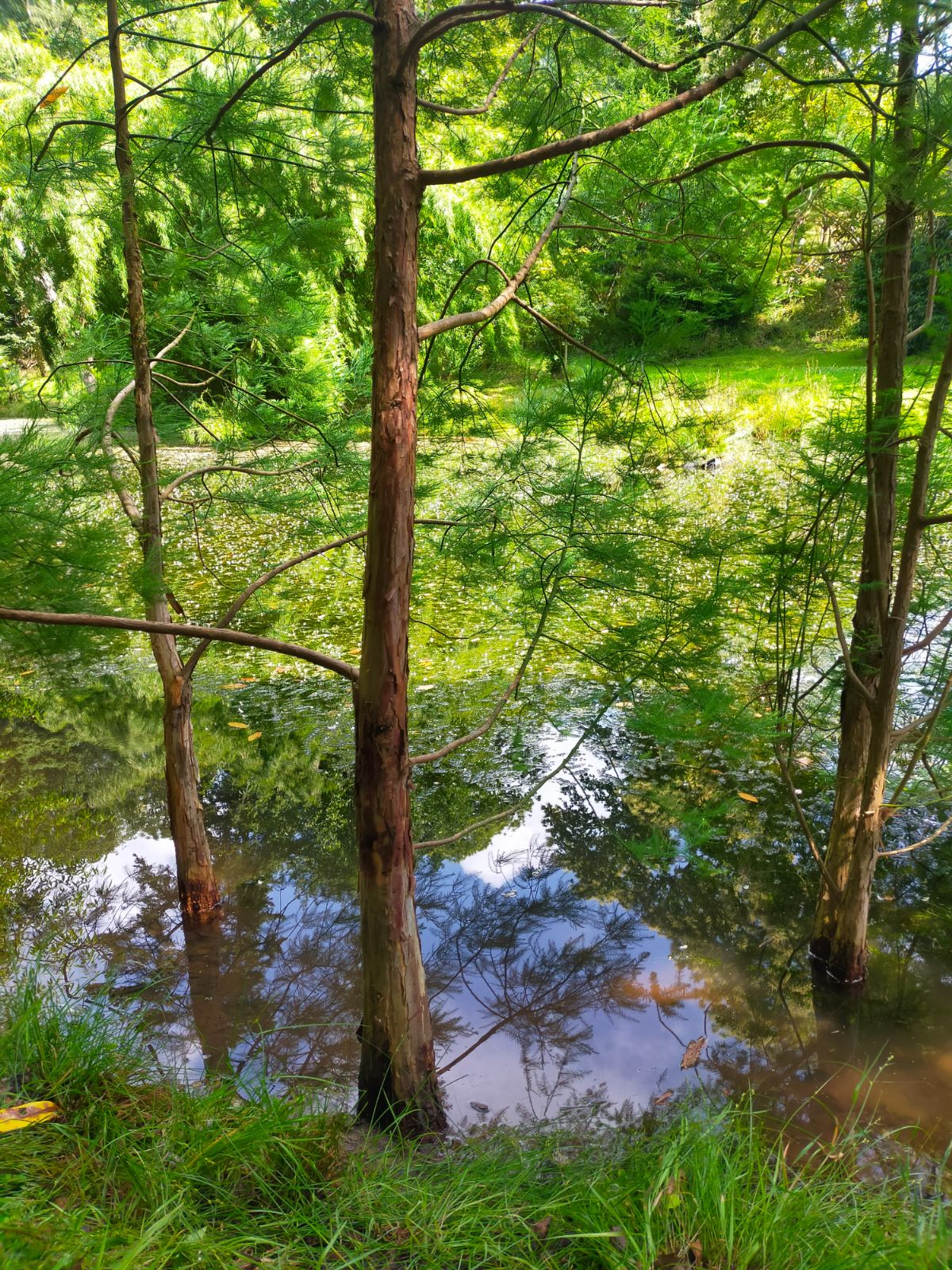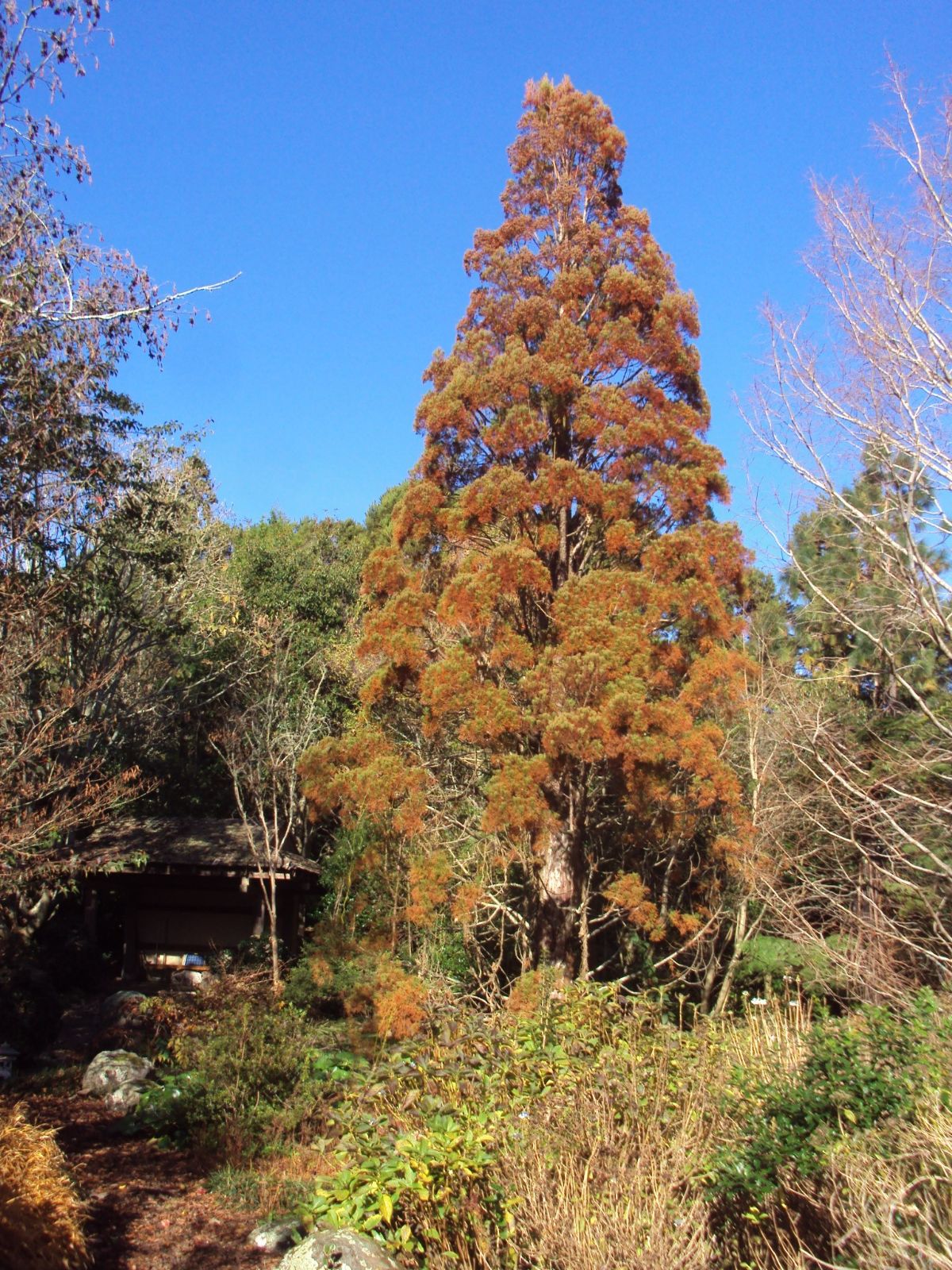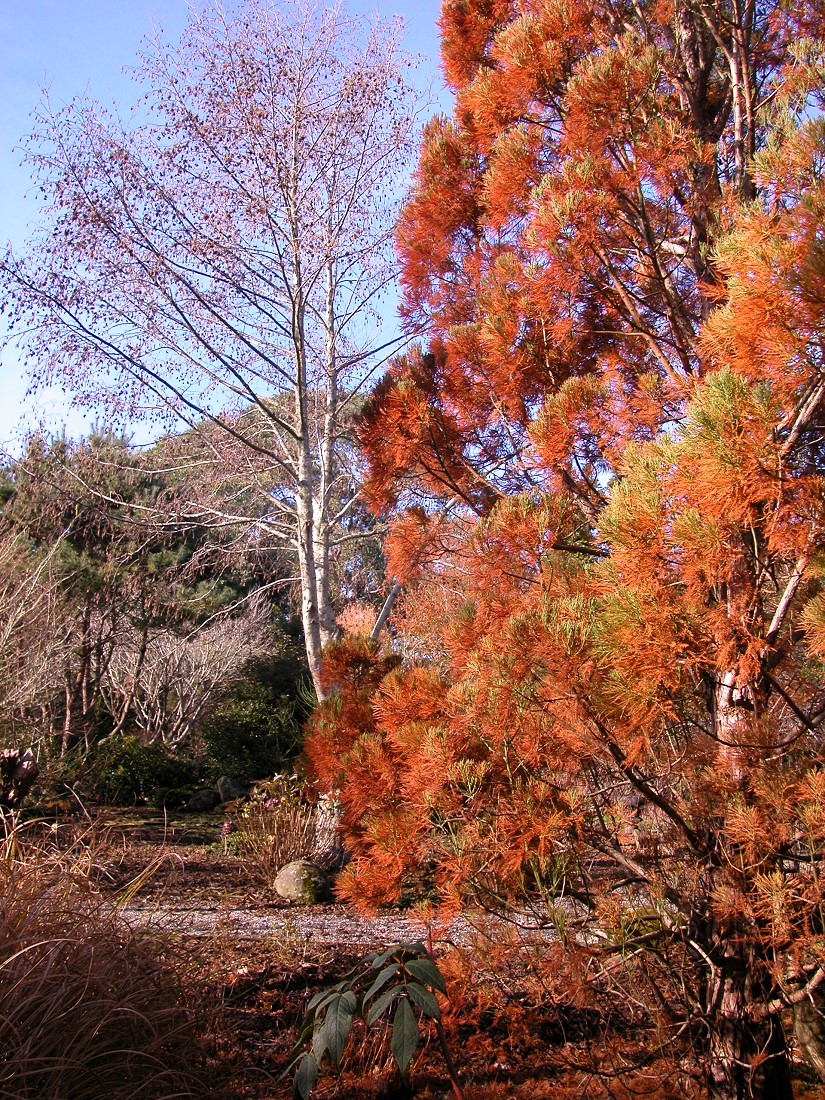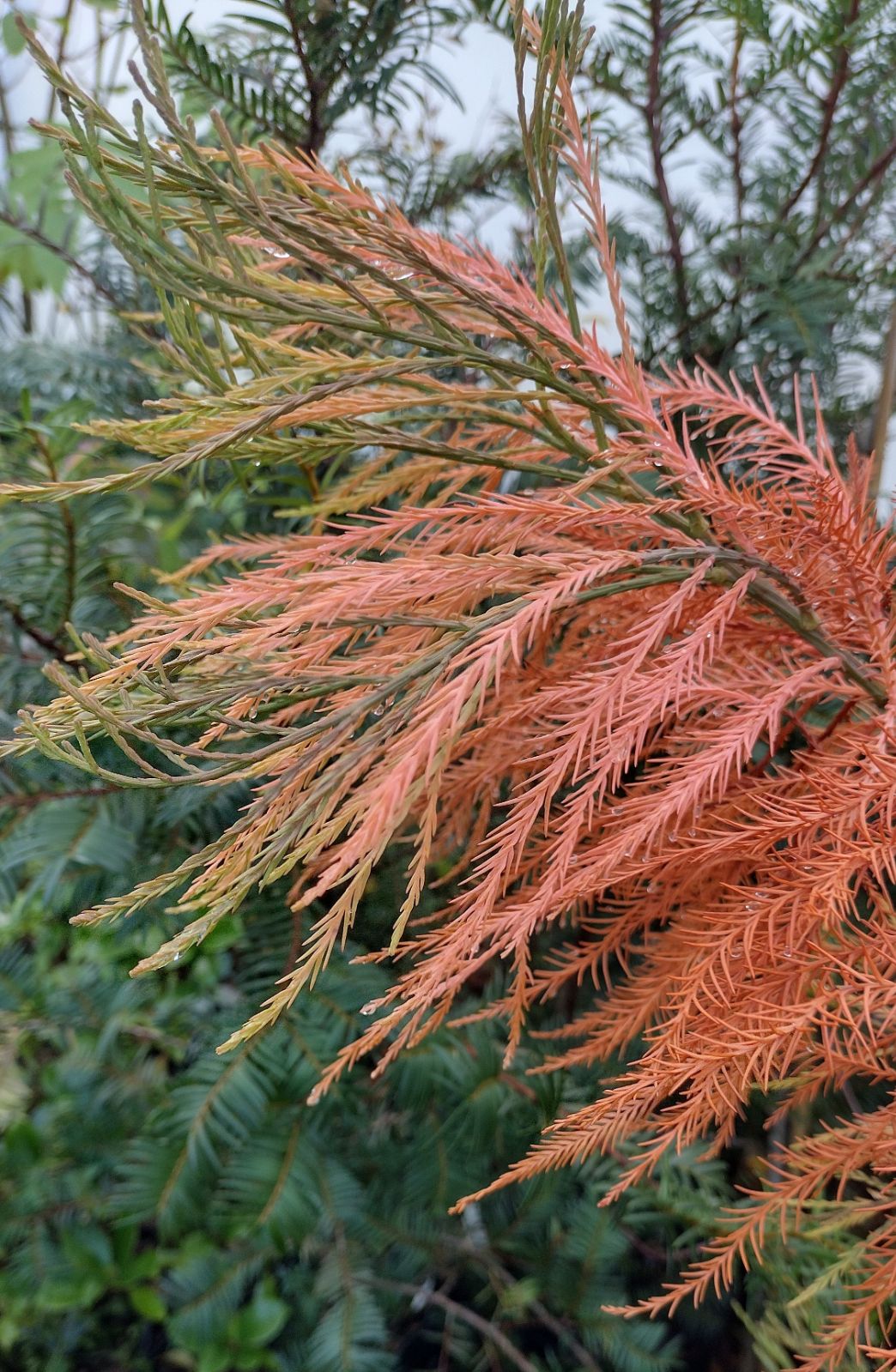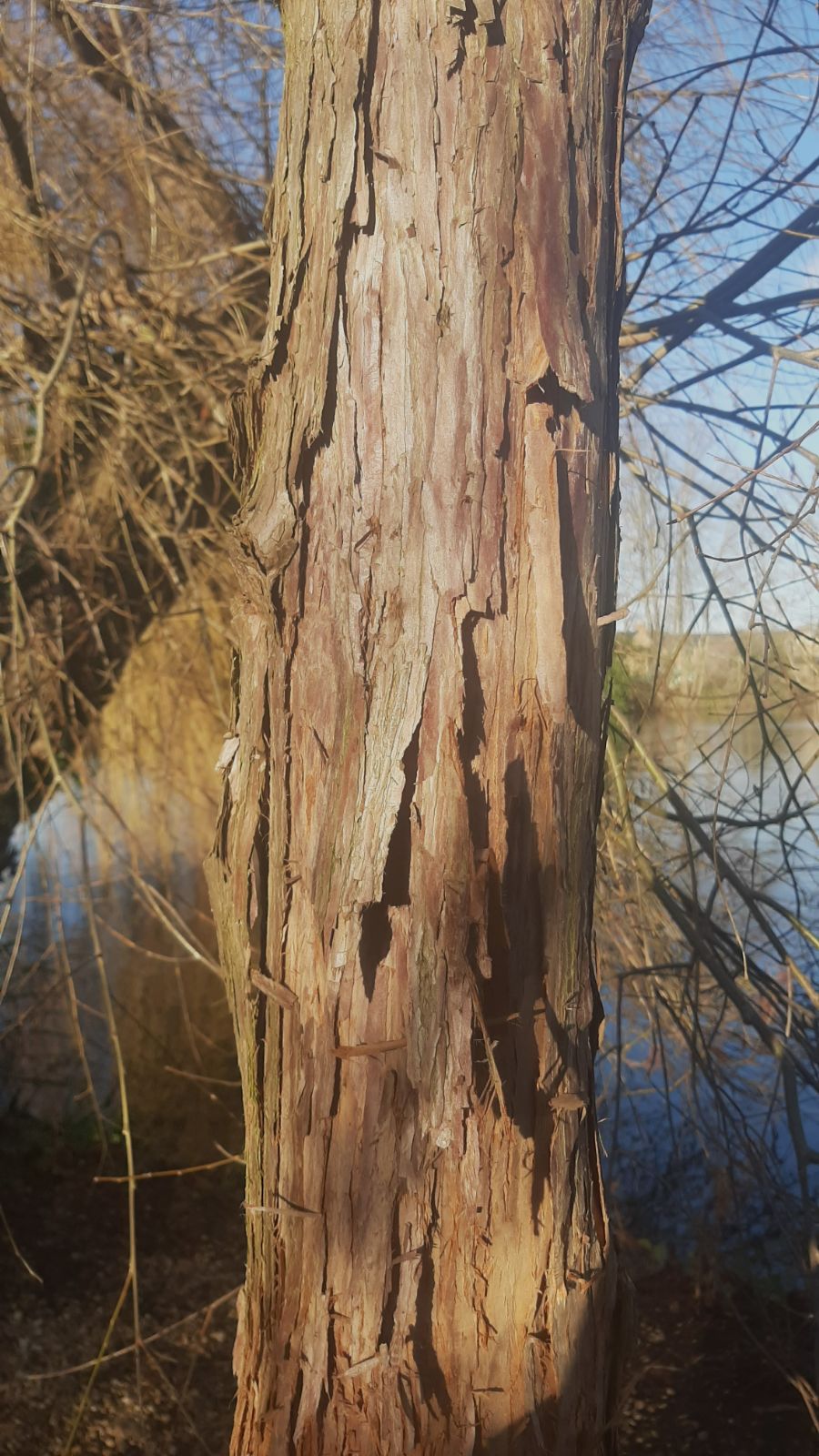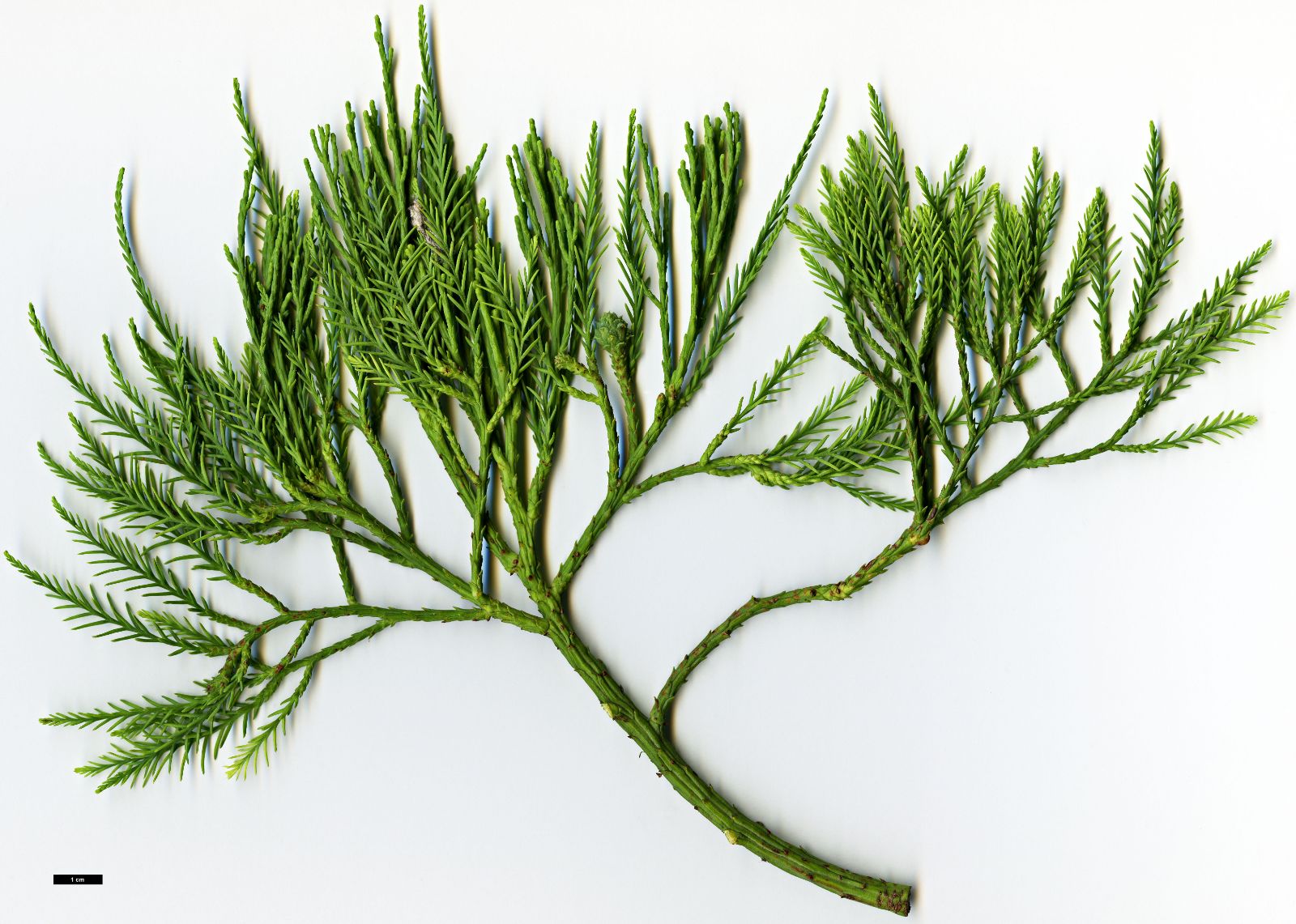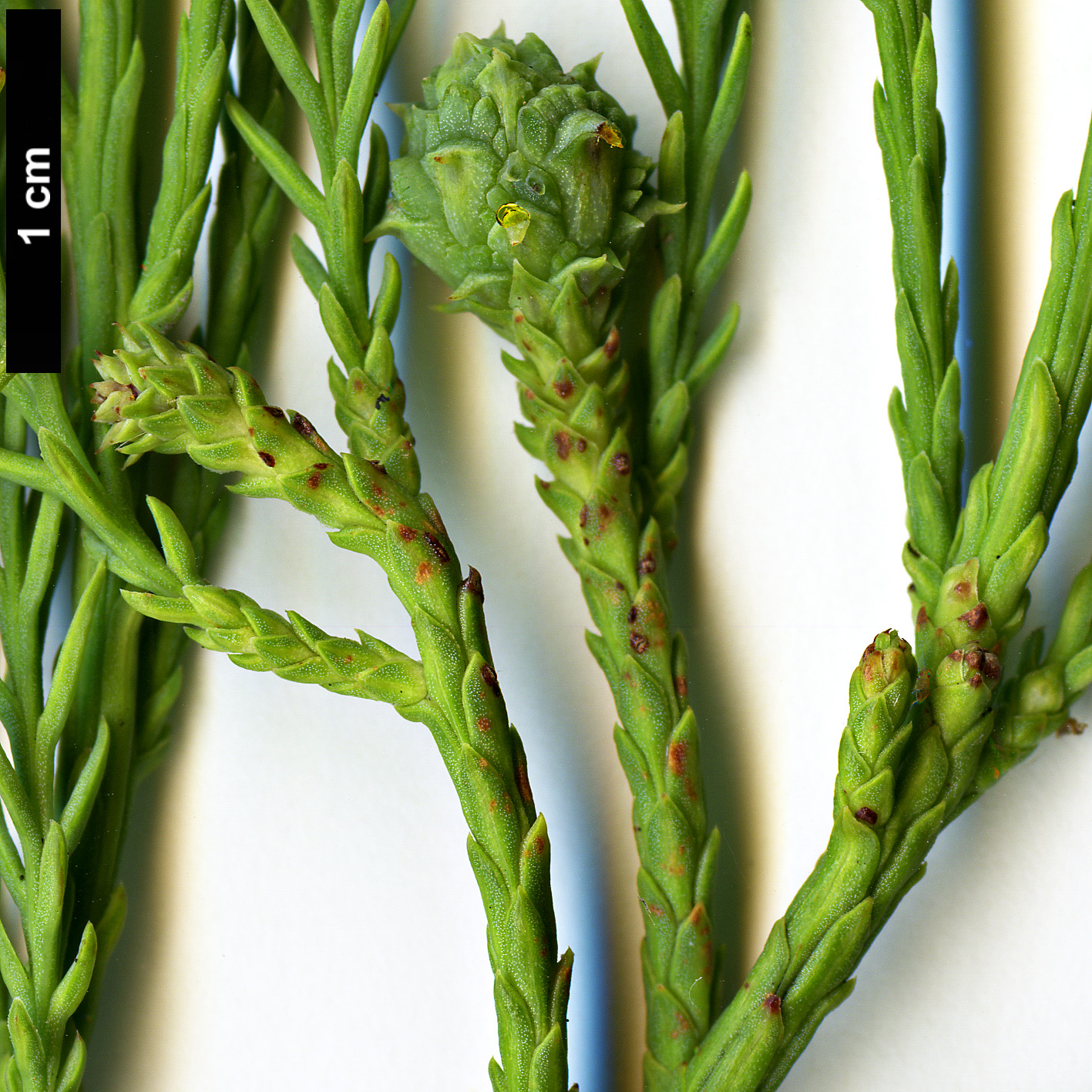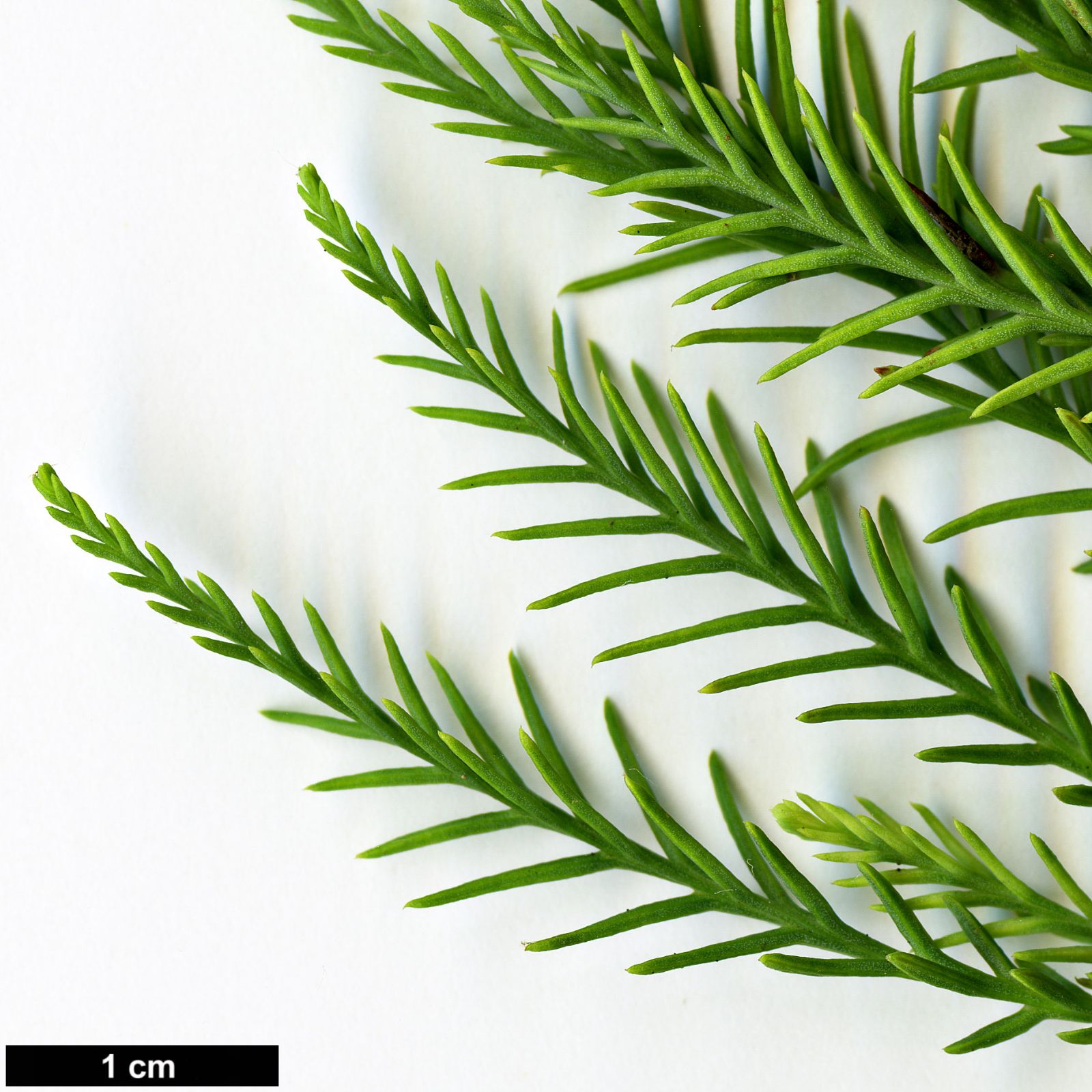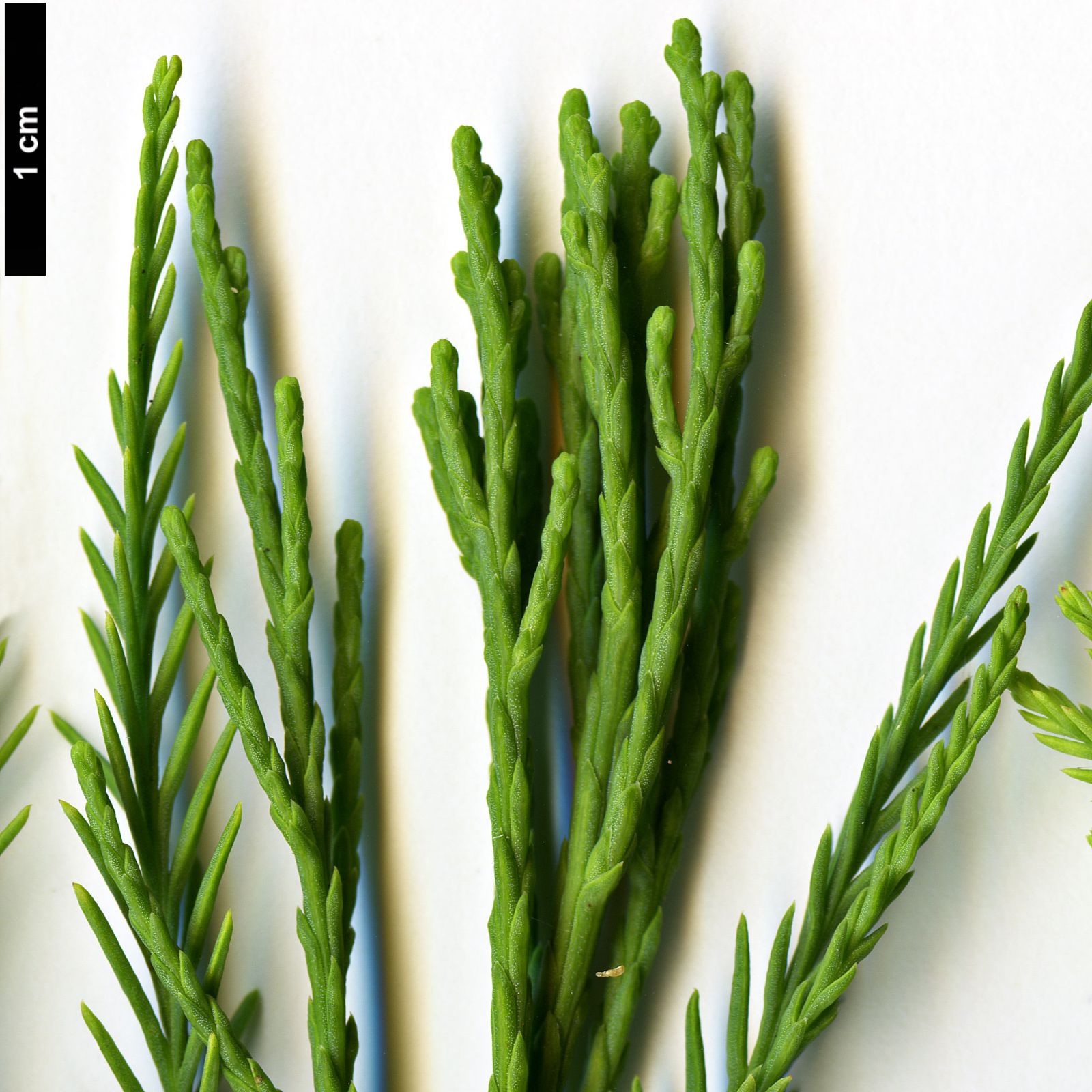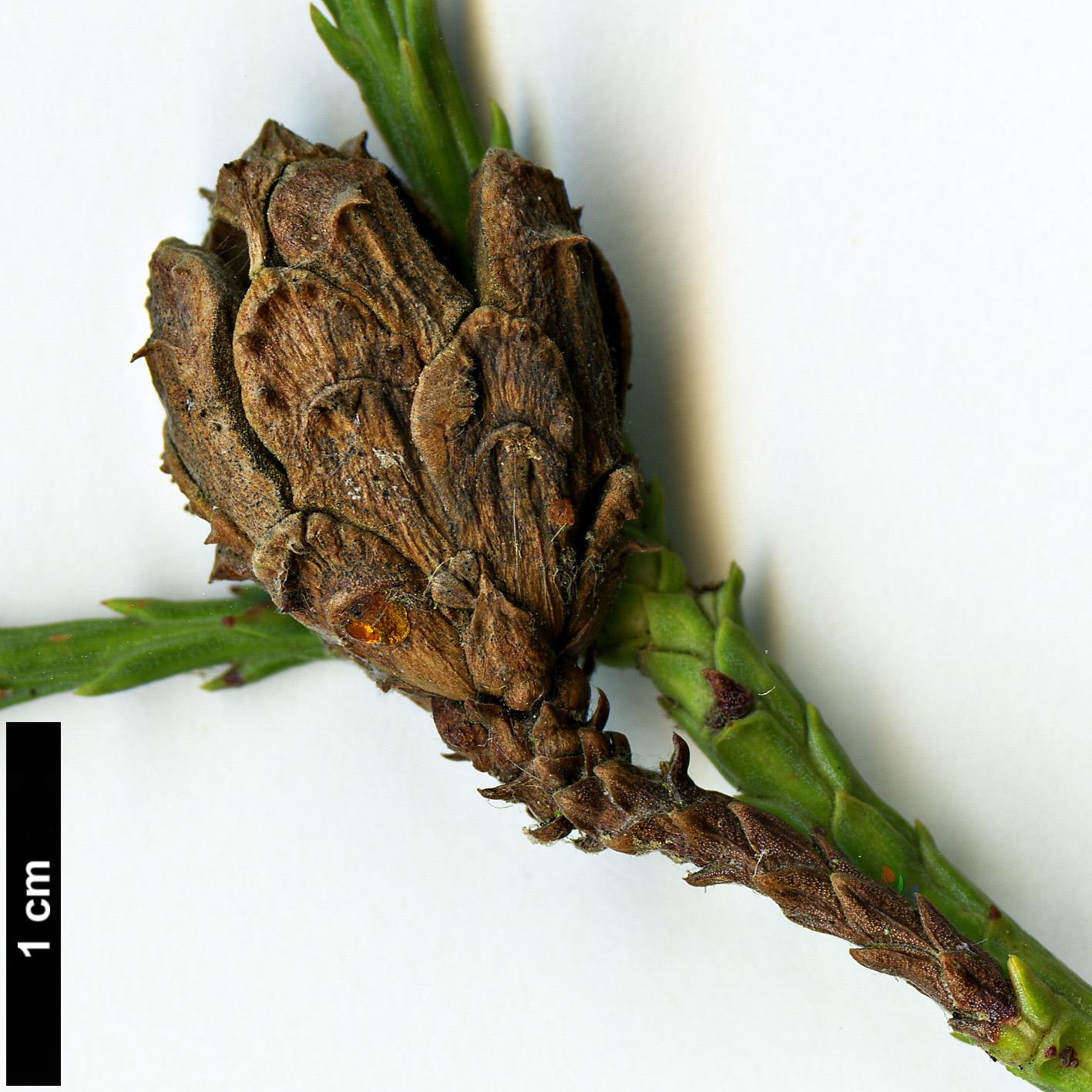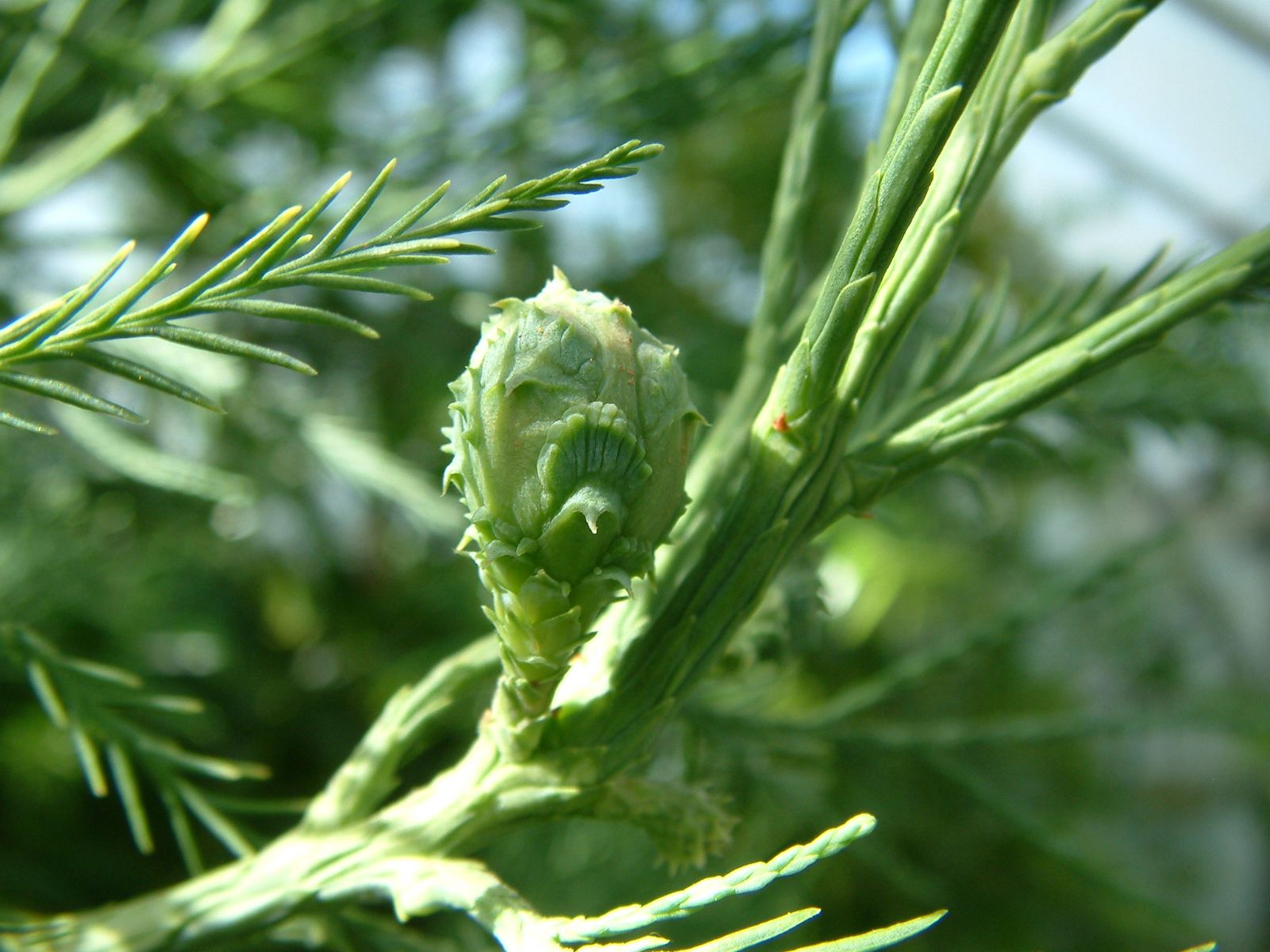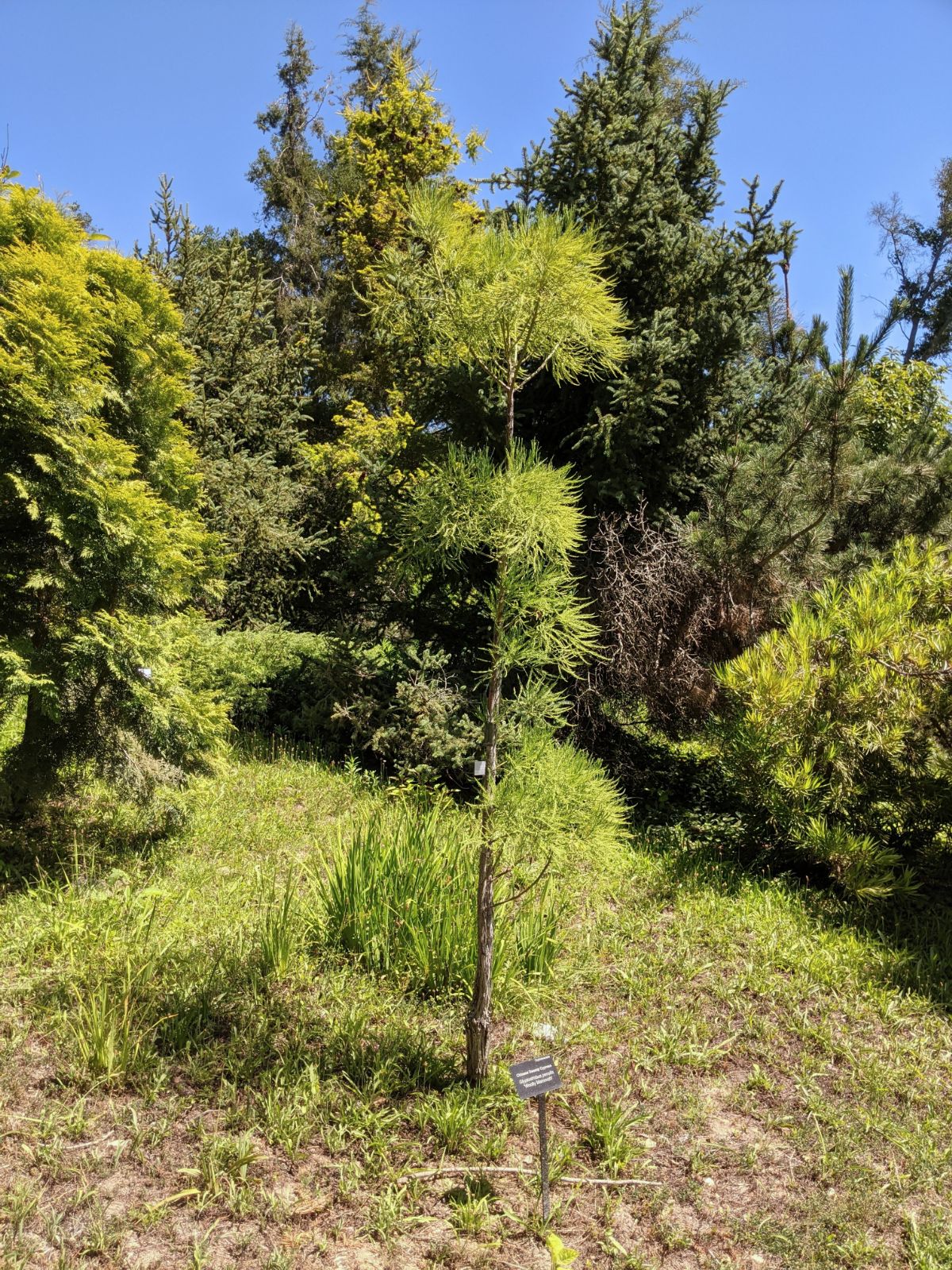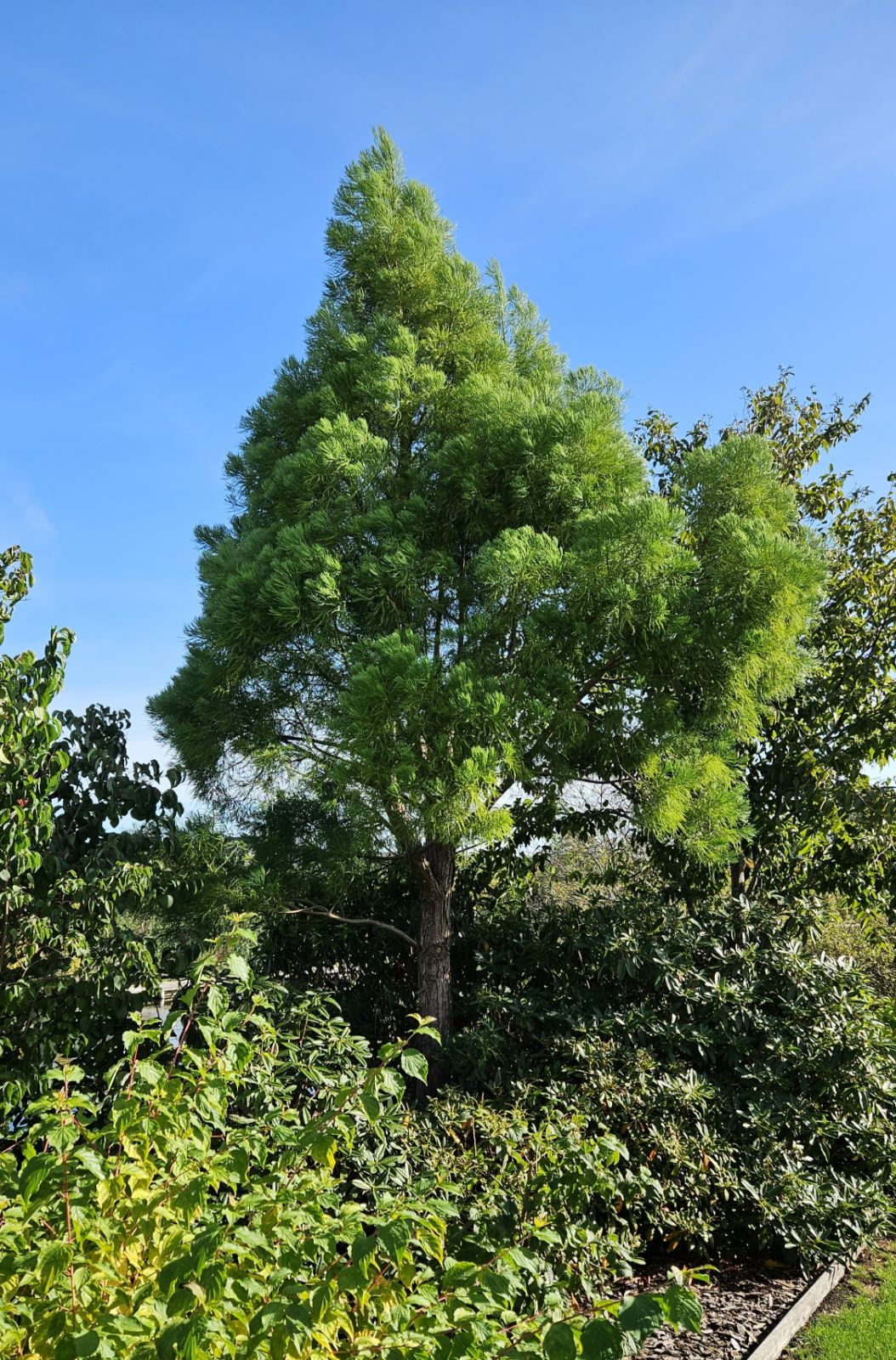Glyptostrobus pensilis
Sponsor
Kindly sponsored by
Monique Gudgeon, Sculpture by the Lakes
Credits
Brian Robertshaw & Tom Christian (2023)
Recommended citation
Robertshaw, B. & Christian, T. (2023), 'Glyptostrobus pensilis' from the website Trees and Shrubs Online (treesandshrubsonline.
Genus
Common Names
- Chinese Swamp Cypress
- Chinese Water Fir
- 水松 (shui song)
- Mai Hing Sam
- Canton Water Pine
Synonyms
- Glyptostrobus heterophyllus (Brongn.) Endl.
- Glyptostrobus lineatus (Poir.) Druce
- Juniperus aquatica Roxb.
- Taxodium sinense J. Forbes
- Thuja pensilis Staunton ex D. Don
A medium sized monoecious, coniferous tree, usually reaching 25 m but apparently up to 56 m × 1.5 m dbh in old growth forest in Lao PDR. Bole prominently buttressed when grown in wet substrates and sometimes also producing short knees. Crown irregular, sparse, open, with distinctive tufts of foliage at the ends of upcurving branches. Bark fibrous, peeling in vertical strips. Branchlet system is dimorphic, divided into branchlets with needle-like leaves which are shed annually as units (annual branchlets), and more persistent, slender branchlets with scale-like foliage (perennial branchlets). Leaves spirally arranged, exhibiting enormous variation in shape within the same branchlet system, representing a continuum between the scale-like leaves of Cupressus and the needle-like leaves of Taxodium. On annual branchlets, especially of young trees, the leaves are distichously arranged, linear and flattened, to 30 mm long; on annual branchlets of older trees leaves resemble those of Cryptomeria, more awl like, quadrangular in cross-section, spreading more radially often into three ranks; leaves on perennial and fertile branchlets are imbricated scales, < 3 mm long with incurving apices. Pollen cones solitary, terminal, on short branchlets 3–5 mm long. Seed cones solitary, terminal on long scaly branchlets, pyriform-obovate in shape, 14–25 mm long; cone scales formed of a bract fused to the seed scale it subtends, visible externally as a transverse ridge, apex decurved, triangular, with the pointed lobes of the seed scale extending distally as in Cryptomeria, these complexes forming a cluster of closely fitting pillars joined at their base by a short rounded stalk parting but not detaching from the rachis at maturity. Two seeds are borne on the adaxial surface of each scale, with a thin wing extending proximally. Flowering January–March (China) with seeds maturing in the same year and cones persisting until the following spring. (Debreczy & Rácz 2011; Silba 1986; Eckenwalder 2009; Fu, Yu & Mill 1999; Henry & McIntyre 1926; Coffman 2021).
Distribution China Fujian, Guanxi, Jiangxi, Zhejiang, Guangdong, Hainan, Sichuan, Yunnan Laos Kammouan and Borikhamxai Provinces Vietnam Dak Lak Province
Habitat In Vietnam and Laos in seasonally flooded swampy forests. Its original habitat probably no longer exists in China, but it is frequently planted and naturalised in many areas along rivers, canals, and near rice paddies.
USDA Hardiness Zone 8
RHS Hardiness Rating H4
Conservation status Critically endangered (CR)
Taxonomic note This species was first collected by Sir George Staunton in China in 1793, who applied the name Thuja pensilis to his specimens; this name only received a validating description much later, when David Don published it in 1824. In the interim the French botanist Poiret described Thuja lineata in (1817). In a manner not especially helpful to contemporary taxonomists, Poiret typified this with two living trees ‘dans le jardin de M. Noisette’. It is now thought that Poiret’s name refers to plants of Taxodium distichum var. imbricarium (Nutt.) Croom rather than the species under consideration here. Endlicher later (1847) published the genus Glyptostrobus, but it was Koch (1873) who correctly placed this taxon there, so the correct name for the species today is Glyptostrobus pensilis (Staunton ex D.Don) K. Koch. The name Glyptostrobus lineatus (Poir.) Druce is sometimes seen, but since this is based on Poiret’s Thuja lineata, it is also a synonym of Taxodium distichum var. imbricarium (Nutt.) Croom (IPNI 2023; Farjon 2023; Henry & McIntyre 1926).
Despite sharing a similar biogeographic history to that of Metasequoia (LePage 2007; LePage, Yang & Matsumoto 2005), shrinking in range from Tertiary dominance to modern riparian relict, and displaying the same remarkable degree of morphological stasis over time, Glyptostrobus is never called a living fossil and has never enjoyed the popularity that usually accompanies the moniker; in fact it remains a scarcely cultivated plant, receiving little of the attention lavished on its more attractive cousin. Nevertheless, ‘living fossil’ is an appropriate accolade for Glyptostrobus; in the Miocene members of the genus grew in Europe, forming extensive forested swamps, a habitat it often shared with members of Taxodium and Metasequoia (Lidgard & Love 2018; Farjon 2008; Eckenwalder 2009; LePage 2007). Like these associates, the genus never seems to have become particularly speciose or morphologically diverse, and living plants of Glyptostrobus closely resemble their fossil congeners (Kunzmann et al. 2009). A range of factors, amongst them aridity and competition from pinaceous genera, are likely to have contributed to the decline of the species’ range (LePage 2007). It continues to grow in the marshy habitats of which it has always been characteristic, but in a relatively narrow region of southern China, Vietnam and Laos.
While indigenous in China, centuries of cultivation on the lowland coastal plain have obscured its natural range. Glyptostrobus pensilis is planted extensively here around rice paddies and watercourses for stabilisation and occasionally for timber. It also has cultural significance, often planted around villages and temples, and given as gifts to those building new houses (Henry & McIntyre 1926; Thomas 2019). In its more natural setting, in the tiny, fragmented populations that still remain in Vietnam and Laos it inhabits swamp margins and seasonally flooded forests (Thomas 2019; Averyanov et al. 2009). It often forms pure stands, but occasionally shares these habitats with species of Sterculia, Pterocymbium, Litsea, Magnolia, Ficus and Dipterocarpus obtusifolius. On drier, more open stands, Elaeocarpus and Syzygium may grow in lower stories (Averyanov et al. 2009; Hiep et al. 2004). In Vietnam it is the only indigenous conifer on these sites, but in Laos it shares the canopy with emergent Dacrycarpus imbricatus.
The Laotian populations were only discovered in 2007. Wetland ecologists were conducting a survey for a hydropower project soon to be built on the Nakai Plateau, when one of them stumbled upon a population of unusual conifers. Rather, it was their pneumatophores which the ecologist quite literally stumbled upon (McGuire 2015; Coffman 2021), later identified to be those of Glyptostrobus (according to Coffman (2021) the pneumatophores of Laotian trees are smaller and more numerous than those in Vietnam, which can grow up to 60 cm tall). The plateau is situated in central Laos, nestled against the foothils of the Annamite mountains that form the spine of Indochina. Dissected by rivers and streams, this remote mosaic of forest is home to a number of rare plants and animals, amongst them the last remaining old-growth forests of Glyptostrobus pensilis. Whilst the main stand to be discovered was soon inundated by the reservoir, later exploration revealed populations of vast, ancient trees, bringing the total to more than six hundred individuals . Unfortunately, this number was soon reduced with the illegal logging of two hundred trees (Coffman 2021; Thomas 2015). The soft and fragrant timber is, like many cupressaceous woods, resistant to decay and much valued for crafts and construction (Averyanov et al. 2009; Thomas 2019; Thomas et al. 2020). In Vietnam, remaining populations form islands of forest amongst coffee plantations, but are vulnerable to changing hydrology and fire. Certainly, the prospects look bleak for this conifer, but perhaps the recent discovery of populations in Laos serve to point out that while their origin is unclear, the conservation value of Chinese populations should not be underestimated (Averyanov et al. 2009; Zhang & Fischer 2021).
Glyptostrobus pensilis has a surprisingly long history of cultivation in the botanic gardens of the West, but while it is generally considered to have been introduced to Europe in the early 1800s (Veitch 1881) it never became popular, the climate generally being too cold. According to Kent & Veitch (1900) it was first introduced by William Kerr in 1804, and early records of its cultivation also exist in France (Blanchard 1829; Brongniart 1833), but all such records should be interpreted with some caution given the taxonomic problems associated with Glyptostrobus from the early 19th century (see taxonomic note, above). For example, Loudon (1838) writes in reference to Britain that there are ‘no living plants in the country’ while shortly afterward Forbes (1839) writes that it was available from Joseph Knight’s Nursery, Chelsea. Some authors have suggested that it was widely available from nurseries in Europe and the United States by the 1850s (e.g. Knight & Perry 1850; Downing & Sargent 1859) but with the benefit of hindsight these records are likely to be errors and the material in question probably represented Taxodium (again, see taxonomic note). Glyptostrobus is listed in numerous returns for the 1931 RHS Conifer Conference (Chittenden 1932) but scrutiny of these leads one to the conclusion that once again many of these must be cases of mistaken identity. Even in the late 20th century the British dendrologist Alan Mitchell was still finding old trees of Taxodium distichum var. imbricarium labelled Glyptostrobus pensilis (Mitchell 1972). For the editors of Bean, who did discuss the genuine article, it was ‘not hardy at Kew’ in the early 20th century, but noted an example ‘about seventy years old’ and 3.6 m × 9 cm dbh (in 1968) growing at Nymans, and another on a wall at nearby Leonardslee (Bean 1981). Curiously the Nymans plant underwent a growth spurt, for it had increased in height by 60 cm when Mitchell measured it two years later in 1970 (Mitchell 1972) although it is conceivable that the plant had been through three seasons, not just two.
A survey of collection catalogues today shows that it remains rare, being present in a number of botanic gardens but as small numbers of individuals in each case (Royal Botanic Garden Edinburgh 2023). Nevetheless, it is one of only four Critically Endangered conifers reported from over fifty ex-situ conservation collections in a BGCI survey of ex-situ conifer collections (Shaw & Herd 2014), but it is dobutful that very many of these represent truly wild provenance: most older extant trees in Britain are probably traceable to a few late 20th century introductions, including those made by the late Chris Page from cultivated trees in China and Japan in 1976, several Keith Rushforth collections, and Chinese Academy of Forestry and Index Seminum seed. It is rarely seen outside specialist collections, but a notable exception is the tree currently belived to be the UK and Ireland champion which may be found by a pond in the grounds of the University of Surrey’s Guildford campus. Planted in 1982, it was 13.2 m tall × 48 cm dbh in 2018, but it has probably been overtaken by at least one of four trees in the Val de la Mar Arboretum on Jersey; raised from Index Seminum seed sent in the late 1970s the best was 13 m × 28 cm in 2013 (Tree Register 2023) and has continued to grow strongly since (TC pers. obs. 2018–2022) Other notable UK specimens are mostly distributed in warmer areas of the south of England; there are curiously few examples recorded from the mild counties of Devon and Cornwall which, at least historically, have probably lacked sufficient summer heat to endow Glyptostrobus with sufficient vigour to attain a large size, although a trio planted by Tom Hudson in the margins of a small lake at Tregrehan, Cornwall in 2015 have romped away and stand c. 6 m tall in 2023 (T. Hudson pers. comm.). A former UK and Ireland champion tree grew in the grounds of Dunloe Castle Hotel in Kerry, Ireland; it was 9 m × 30 cm in 2002 but dead by 2004 (Tree Register 2023). A surprising record is a tree 11 m × 42 cm dbh (in 2017) in West Park, Wolverhampton, Staffordshire, which is notable for being (traditionally, at least) a rather cold part of England (Tree Register 2023).
Better trees may be found in more consistent climates. Glyptostrobus pensilis is not uncommon in specialist collections in parts of Australia and New Zealand with reliably warm summers and mild winters. Several accessions are grown at Mount Lofty Botanic Garden, South Australia (The Botanic Gardens of South Australia 2023) and Eastwood Hill, New Zealand (Eastwoodhill Arboretum 2023); the best tree on record in New Zealand grows in Christchurch Botanic Garden and was 25 m × 1.02 m dbh in 2012 (New Zealand Notable Trees Trust 2023). Three beautiful, columnar, clonal trees grow in Glyn and Gail Church’s garden near New Plymouth and are 16–18 m tall aged c. 25 years; they were raised as cuttings from a single tree growing in Palmerston North and have themselves been propagated and sold or distributed to several other New Zeland gardens (G. Church pers. comm. 2023).
In North America it is more or less restricted to the southern states and milder areas of the Pacific coast. At the JC Raulston Arboretum two plants raised from seed received in 2007 grew quickly to 4.5 m (by 2019) and 8.2 m (by 2014) (JC Raulston Arboretum 2023); the latter example has presumably benefitted from additional shelter but both serve to illustrate the suitability of the climate here. Glyptostrobus appears to be hardy in the eastern US at least as far north as the US National Arboretum, Washington DC, where a group of trees near the administration building are among the best known to Laurence Hatch in an area colder than zone 7 (Hatch 2021–2022). The west coast is home (for now) to the largest recorded specimen in North America: 19.8 m × 44.7 cm dbh (in 2007) growing in the arboretum at University of California, Davis (A.L. Jacobson in Earle 2023). Glyptostrobus is grown at Sonoma Botanical Garden, California where trees planted in 2006 and 2007 are both now (2023) c. 3 m tall and 9.5 cm and 7.3 cm dbh (2006.199*A and *B respectively) (M. Wenzel pers. comm. 2023). Although planted near water neither is growing in overly wet soils, but both are rather lanky trees (TC pers. obs.).
Glyptostrobus, Farjon writes, is a ‘truly semi-aquatic tree’ (Farjon 2023) and several horticultural commentators have observed that it not only prefers but requires the (seasonal) innundation characteristic of the places it is found in the wild, unlike its relative Taxodium which in fact grows better on moist but well drained sites in cultivation (Dirr 2009; Bean 1981). This may be true of areas like the UK where the climate is subject to the vagaries of an oceanic influence and winters are generally cold, and where Glyptostrobus is rendered hardier by inundation (Rushforth 1987), but as some of the examples cited above serve to demonstrate inundation is not necessarily essential in warmer areas like California. In his garden near New Plymouth, New Zealand, Glyn Church has found the species grows well in wet and boggy ground but balks at inundation in standing water (G. Church pers. comm. 2023). Further experimentation on this point would be welcome.
While the choice of tree for wet sites will often be Taxodium distichum, being faster growing and hardier (More & White 2013), Glyptostrobus retains a deeper autumnal shade of glowing red and for longer than that species, for several weeks into winter (Rushforth 1987) and deserves consideration. That said, it is only very rarely offered for sale by specialist nurseries, and is more commonly (though still rarely) passed between collectors. It can be raised from semi-ripe or hardwood cuttings, or from seed, and shows compatibility with Taxodium onto which it is often grafted (Rushforth 1987; D. Luscombe pers. comm.). Auders & Spicer (2012) point out that, unusually, the graft should be planted below soil level to encourage the scion wood to root.
'Woolly Mammoth'
A recent introduction, before 2010, from Rob Means of Yadkin Valley Nursery in Yadkinville, North Carolina, ‘Woolly Mammoth’ is described as having a better growth form than the typical species and slightly bluish young growth (Polomski 2014). It is in commerce in Europe and North America.
A plant at Sonoma Botanical Garden, accessioned in 2010 and planted in 2014, had reached 2.4 m × 4.4 cm dbh by 2023 (M. Wenzel pers. comm.) It cannot be said to be particularly beautiful, but curiously this plant is growing with a range of other Asian conifers on a steep slope on rather dry, albeit irrigated soils, certainly a far cry from the perpetually moist and seasonally inundated soils of its native habitat and usually recommended in cultivation. The lanky habit of this and two other typical Glyptostrobus in the collection at Sonoma may be a response to the Mediterranean climatic regime whose heat suits this species but whose dryness does not.

